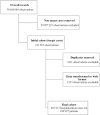Epidemiology of spontaneous pregnancy loss in Kazakhstan: A national population-based cohort analysis during 2014-2019 using the national electronic healthcare system
- PMID: 37667510
- PMCID: PMC10619606
- DOI: 10.1111/aogs.14669
Epidemiology of spontaneous pregnancy loss in Kazakhstan: A national population-based cohort analysis during 2014-2019 using the national electronic healthcare system
Abstract
Introduction: Spontaneous pregnancy loss (SPL) is a common health problem that affects 1:10 of childbearing women, and is linked with physical and psychological complications. As the number of nationwide studies on the incidence of SPL is few, especially from middle-income countries, in this study we investigated the epidemiology, complications and outcomes of SPL before 22 weeks of gestation by analyzing large-scale healthcare data from the Unified Nationwide Electronic Healthcare System (UNEHS) in Kazakhstan.
Material and methods: A population-based study among women who experienced SPL in any healthcare setting of the Republic of Kazakhstan during the period of 2014-2019. The International Classification of Diseases (ICD) 10th edition and ICD 9th edition's procedural codes were utilized to retrieve data using relevant diagnostic and procedural codes.
Results: In total, 207 317 records of women who have experienced an SPL before 22 weeks of gestation were analyzed from all Kazakhstani regions. The estimated prevalence of SPL was 8.7%, with a 20% decline over a 6-year period. The SPL cases ratio comprises on average 6.2 per 1000 reproductive-age women. Incomplete miscarriage (ICD-10 code "O03.4") was the most common type (37.8%), followed by blighted ovum (ICD-10 code "O02.0"; 34.1%) and missed abortion (ICD-10 code "O02.1"; 13.5%). The most common management methods were dilation and curettage of the uterus (ICD-9 code "69.0"; 84.7%) and aspiration curettage of the uterus (ICD-9 code "65.0"; 15%), whereas medical management was rarely performed (2.6%).
Conclusion: The information available in UNEHS adequately identifies types of miscarriages and treatment methods. Although the prevalence of SPL before 22 weeks of gestation is decreasing, management of miscarriages requires closer attention.
Keywords: epidemiology; maternity care; miscarriage; spontaneous pregnancy loss; women's health issues.
© 2023 The Authors. Acta Obstetricia et Gynecologica Scandinavica published by John Wiley & Sons Ltd on behalf of Nordic Federation of Societies of Obstetrics and Gynecology (NFOG).
Conflict of interest statement
The authors have stated explicitly that there are no conflicts of interest in connection with this article.
Figures



References
-
- Kolte AM, Bernardi LA, Christiansen OB, et al. Terminology for pregnancy loss prior to viability: a consensus statement from the ESHRE early pregnancy special interest group. Hum Reprod. 2015;30:495‐498. - PubMed
-
- Griebel CP, Halvorsen J, Golemon TB, Day AA. Management of spontaneous abortion. Am Fam Physician. 2005;72:1243‐1250. - PubMed
-
- Dugas C, Slane VH. Miscarriage. StatPearls. StatPearls Publishing; 2022. Accessed January 1, 2023. https://www.ncbi.nlm.nih.gov/books/NBK532992/ - PubMed
-
- Quenby S, Gallos ID, Dhillon‐Smith RK, et al. Miscarriage matters: the epidemiological, physical, psychological, and economic costs of early pregnancy loss. Lancet. 2021;397:1658‐1667. - PubMed
MeSH terms
Grants and funding
LinkOut - more resources
Full Text Sources
Medical
Research Materials

